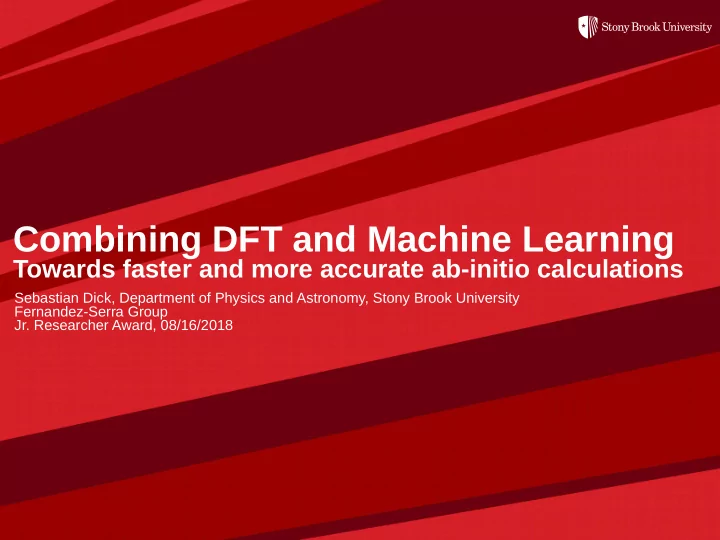

Combining DFT and Machine Learning Towards faster and more accurate ab-initio calculations Sebastian Dick, Department of Physics and Astronomy, Stony Brook University Fernandez-Serra Group Jr. Researcher Award, 08/16/2018
Introduction
Simulations in Molecular Sciences ● Force Fields Energies , Atomic Forces , ● Density Functional Theory coordinates Stress, (DFT) Electron density, Spectra, ... ● Quantum Chemistry We use DFT because: ● Can scale to large systems sizes (100s to 1000s of atoms) + Periodic boundary conditions → Condensed systems ● Non-empirical, hence unbiased ● Fully reactive 3
How does DFT work ? Hohenberg - Kohn Quantum ? Mechanics 4
How does DFT work ? Hohenberg - Kohn Quantum Mechanics 5
Jacob’s ladder ● A density functional approximation is uniquely defined by choosing ● Accuracy, Cost ↔ Locality PBE0, What we would like Hybrid functionals, MP2, RPA ... B3LYP to do meta-GGA TPSS Accuracy What we end up Generalized-Gradient PBE, doing... Approximation (GGA) BLYP PW92 Local Density Approximation (LDA) 6
Machine learning in Molecular Sciences Force Fields Electronic Structure Towards Exact Molecular Dynamics Simulations By-passing the Kohn-Sham equations with Machine-Learned Force Fields with machine learning Chmiela et al, arXiv:1802.09238 (2018) Brockerde et al., Nature Comm. 8 (2017) SchNet – A deep learning architecture Finding density functionals with machine learning for molecules and materials Snyder et al, Phys. Rev. Lett. 108 (2012) JCP 148 (2018), Schutt et al Semi-local machine-learned kinetic Generalized Neural-Network Representation of energy density functional High-Dimensional Potential-Energy Surfaces with third-order gradients of electron density PRL 98 (2007), Behler, Parrinello Seino et al, JCP 148 (2018) 7
Machine learning in Molecular Sciences Our idea: Machine Learned Correcting Functionals (MLCFs) Train a neural network on the difference in predictions of physical observables (E, F, ...) of a lower accuracy baseline method (GGA) and a higher level reference MLCF method (Hybrid DFT, Coupled Cluster, …) → get a higher accuracy at the cost of the baseline method Force Fields Electronic Structure Towards Exact Molecular Dynamics Simulations By-passing the Kohn-Sham equations with Machine-Learned Force Fields with machine learning Chmiela et al, arXiv:1802.09238 (2018) Brockerde et al., Nature Comm. 8 (2017) SchNet – A deep learning architecture Finding density functionals with machine learning for molecules and materials Snyder et al, Phys. Rev. Lett. 108 (2012) JCP 148 (2018), Schutt et al Semi-local machine-learned kinetic Generalized Neural-Network Representation of energy density functional High-Dimensional Potential-Energy Surfaces with third-order gradients of electron density PRL 98 (2007), Behler, Parrinello Seino et al, JCP 148 (2018) 8
Machine learned correcting functionals (MLCFs)
Machine Learning Informed Machine Learning for Maximal Extrapolation Rather than provide all available (raw) data in an unbiased way, knowledge about the physical mechanisms involved is used to pre-process and select relevant data. Trained on a small representative dataset the model should generalize to unseen data . In particular, the model has to be valid for arbitrary system sizes . 10
Data Dataset: Water – Training: 640 Monomers, 1600 Dimers, 1200 Trimers – Testing: 160 Monomers, 400 Dimers, 300 Trimers, 50 Tetramers, 50 Pentamers, … Input: Expansion of electron density around each atom into basis functions: Electronic descriptors: Atomic species Atom index Targets: Difference between reference (MB-pol) and baseline (GGA + vdW) energies(/forces) 11
Architecture 12
Performance on water clusters 2-body energy Molecules DFT DFT+MLCF DFT DFT+MLCF 1 -4.2 -1.4 64.3 2.0 2 -5.8 -1.3 42.5 3.4 3 -14.8 0.6 31.9 2.3 4 -31.2 -1.0 9.4 2.7 5 -31.9 0.0 12.3 3.0 8 -28.9 2.3 9.3 3.1 16 -26.1 6.6 6.2 2.5 Energies in meV/molecule 3-body energy Hexamers Fritz, Fernandez-Serra, Soler, J. Chem. Phys. 144, 224101 (2016), Supplementary Information 13
Correcting molecular dynamics simulations ● Ab initio molecular dynamics: Integrate the equations of motion with forces obtained from ab-intio calculations. ● GGA (DFT) is known to over-structure liquid water (peaks too high) ● Even though simulations not well converged yet (simulation time too short), MLCFs seem to correct this over-structuring Simulation of a box with periodic DFT boundary conditions containing Reference (MB-pol) 128 water molecules, with Nose-Hoover DFT + MLCF Thermostat at 300 K 14
Using MLCFs to speed up MD calculations ● Start from very fast DFT calculation with very low accuracy (GGA, minimal basis set, coarse grid, relaxed convergence criteria) ● Large difference between baseline and reference → only approximate correction ● Solution: Every n-th MD step use reference method to calculate correction ● Speed-ups of up to a factor of 8 for water ● But: possible speed-up system dependent, careful validation necessary 15
Outlook
Python toolkit * Implementation with C++ kernel and MPI/CUDA planned Electronic Structure code ** Uses GPUs through Tensorflow Import and preprocess electron density Energy calculations, * Structural relaxation, Molecular dynamics, ... Propose NN based on User can make Provided data adjustments Atomic simulation Cross-validation and Final model : Environment training ASE Calculator (ASE) ** ** Python toolkit 17
Timeline Timeline for 2018/2019: ● Sep – Dec: ● Implementation of basic Python toolkit, v0.1 on Github ● First publication on MLCFs ● Using MLCFs to study the solvation of NaCl in water (together with Alec Wills) ● Jan – Apr: ● Performance optimization (C++ and MPI/CUDA), v1.0 on Github ● MLCF accelerated simulations of water-metal interfaces ● May – Aug: ● MLCF accelerated simulations of water-metal interfaces ● MLCFs as an alternative to QM/MM? Implementation of QM/QM-MLCF algorithms. Plans for 2019/2020: ● Can ML be used to correct the self consistent electron density? (Possible collaboration with Alan Aspuru Guzik @ Toronto) ● Machine learned density functional kernels? ● Other semi-empirical methods for faster electronic sturcture calculations (Electron ‘force-field’, Collaboration with Jose Solers group @ Madrid) 18
Thank you!
Using MLCFs to speed up MD calculations Replace QM/MM with QM/QM-MLCF: MM QM-MLCF ? QM QM 20
Recommend
More recommend